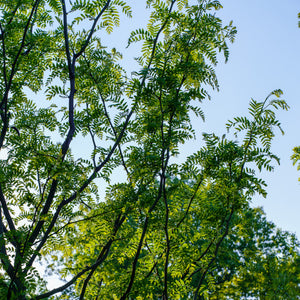The Honeylocust Guide
Honeylocust trees, part of the Gleditsia genus, bring a unique and enduring presence to any landscape. With their graceful form, delicate foliage, and ecological significance, honeylocusts capture attention and infuse a touch of distinction into gardens and outdoor spaces. These remarkable trees are celebrated for their adaptability and their ability to thrive under diverse conditions with appropriate care and maintenance. Whether you aim to create a serene woodland getaway or desire a standout addition to your garden, honeylocusts are an excellent choice.
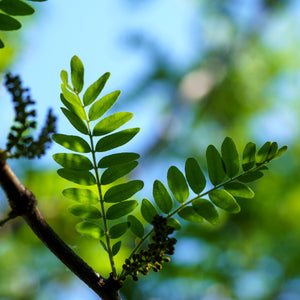
About
Honeylocust trees, belonging to the Gleditsia genus, encompass a diverse group of deciduous trees celebrated for their captivating presence and ecological importance. This remarkable genus includes several recognized species found across North America and other temperate regions.
Honeylocust trees are known for their graceful form, bipinnately compound leaves, and ecological significance. They offer a striking appearance that enhances gardens and natural landscapes. Honeylocust trees typically showcase vibrant green foliage during the growing season. As autumn approaches, they undergo a stunning transformation, adorning themselves with a range of warm colors, including shades of yellow, orange, and copper.
Their role in local ecosystems is profound, as honeylocust species provide sustenance and shelter for an array of wildlife. Their seed pods, resembling long, twisted beans, serve as a valuable food source for animals such as deer and squirrels. Their flowers, in clusters, are important for pollinators.
Honeylocust trees are adaptable to different soil types and environmental conditions. They can grow in a variety of soils, although they thrive in moist, well-drained locations. Their moderate growth rate makes them a popular choice for ornamental and ecological landscaping.
Whether you plant honeylocust trees as ornamental specimens, use them for providing shade, or incorporate them into mixed borders, these trees offer beauty and ecological contributions, making them an outstanding addition to any landscape. Popular species of honeylocust trees include the common honeylocust (Gleditsia triacanthos) and the thornless honeylocust (Gleditsia triacanthos inermis).
By selecting and caring for honeylocust trees in your landscape, you not only enhance the aesthetic appeal of your outdoor space but also contribute to the preservation of these remarkable trees and the biodiversity they support.
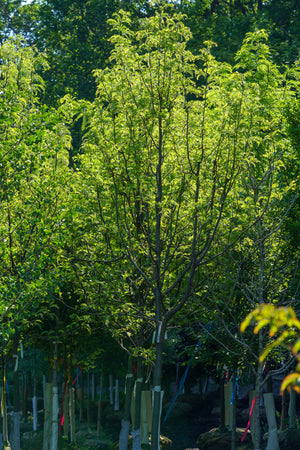
Planting
Honeylocust trees, belonging to the Gleditsia genus, have specific planting requirements to ensure their successful establishment and healthy growth. Here are some general guidelines for planting and caring for honeylocust trees:
Soil: Honeylocust trees thrive in well-draining soil that is rich in organic matter. They prefer slightly acidic to neutral soil with a pH between 6.0 and 7.0. Prior to planting, prepare the site by loosening the soil and incorporating compost or organic matter to enhance both drainage and soil fertility.
Sunlight: Honeylocust trees do well in full sun to partial shade. When selecting a planting location, aim for an area that receives at least six hours of direct sunlight each day for optimal growth. These trees can tolerate partial shade, particularly in regions with hot and dry climates.
Watering: Adequate watering is crucial, especially during the initial establishment of honeylocust trees. Water deeply right after planting and continue to provide regular irrigation throughout the first year. Water deeply and thoroughly once or twice a week, depending on rainfall and soil moisture levels. Avoid overwatering, as excessive moisture can lead to root rot.
Mulching: To conserve moisture, suppress weed growth, and regulate soil temperature, apply a layer of organic mulch around the base of your honeylocust tree. Suitable mulch materials include wood chips, bark, or compost. Ensure that the mulch is kept a few inches away from the tree's trunk to prevent excess moisture buildup, which could lead to trunk issues.
Pruning: Honeylocust trees typically require minimal pruning. Remove any dead, damaged, or crossing branches to maintain a strong and balanced framework. Pruning is best done during late winter or early spring while the tree is still dormant, before new growth emerges.
By following these basic planting and care guidelines, you can ensure the successful establishment and healthy growth of your honeylocust trees. This will allow them to thrive and contribute to the beauty of your landscape for years to come.
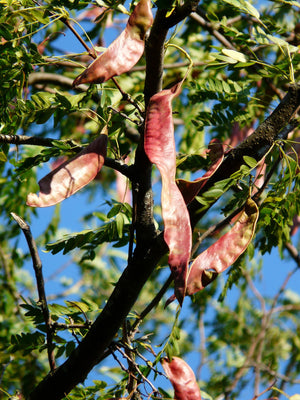
Care
Honeylocust trees require specific care to ensure their optimal growth and health. Here are some general guidelines for the care of honeylocust trees:
Watering: During the growing season, provide moderate watering to your honeylocust trees. Aim for about one inch of water per week, adjusting as needed based on rainfall. It's essential to water deeply and thoroughly to promote deep root growth. Shallow watering can lead to stress and dehydration, especially during periods of drought or high temperatures. Be prepared to provide additional watering when necessary to maintain consistently moist soil.
Pruning: Honeylocust trees typically do not require extensive pruning. However, it's advisable to remove any dead or damaged branches to maintain the tree's overall health and appearance. Shaping the tree to achieve the desired size and form is an option. Prune during late winter or early spring before new growth emerges, using clean and sharp pruning tools to minimize the risk of damaging the tree. Deadheading spent flowers can also encourage new growth and potentially trigger a second blooming.
Fertilizing: Fertilizing can promote healthy growth and foliage in honeylocust trees. Apply a balanced, slow-release fertilizer in the spring or early summer, following the recommended application rates and timing provided by the manufacturer. It's crucial to avoid over-fertilizing, as excessive nutrients can harm the tree's roots. When in doubt, use a bit less fertilizer to prevent overfeeding.
Soil and Sunlight: Honeylocust trees prefer well-drained, moist soil and thrive in full sun exposure. While they are relatively tolerant of different soil types, well-draining soil is essential for their optimal growth. Additionally, mulching around the base of the tree helps retain moisture and regulate soil temperature.
Pests and Diseases: Honeylocust trees are generally resistant to pests and diseases. However, it's essential to monitor for common issues like webworms, spider mites, or cankers. If you observe any signs of damage or disease, promptly treat the tree with appropriate insecticides or fungicides to prevent further issues.
By following these basic care guidelines, your honeylocust trees will thrive, providing beauty, shade, and a majestic presence in your garden for years to come.
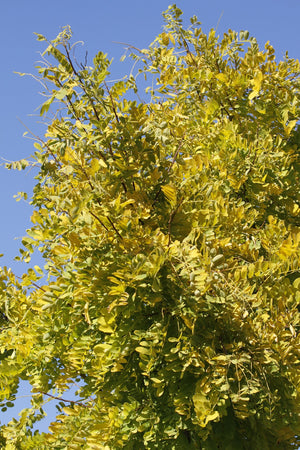
How To Use
Honeylocust trees offer versatility and can be used in various ways to enhance your landscape. Here are some recommendations based on their characteristics:
Focal Point: Honeylocust trees possess a remarkable presence, making them an ideal choice as a focal point in your landscape. Plant a single honeylocust tree in an open area to showcase its graceful form and delicate foliage. Alternatively, create a stunning visual impact by planting a group of honeylocust trees together.
Shade Provider: With their broad canopy and dappled shade, honeylocust trees provide excellent shade. Plant them strategically near outdoor seating areas, patios, or decks to create a cool and comfortable space where you can relax and enjoy the outdoors, especially on hot summer days.
Windbreak: Honeylocust trees, with their dense foliage and sturdy growth, can serve as an effective windbreak. Plant them in a row to shield your garden or home from strong winds, providing a natural barrier and protection.
Privacy Screen: Utilize the dense foliage of honeylocust trees to create a natural privacy screen in your landscape. Plant them in a row along your property line to establish an attractive and functional barrier that enhances both privacy and aesthetics.
Wildlife Habitat: Honeylocust trees contribute to the overall biodiversity of your garden by attracting various wildlife species. Birds and other animals are drawn to the seeds and shelter provided by honeylocust trees. Create a welcoming habitat by planting honeylocust trees and enjoy the sights and sounds of wildlife flourishing in your outdoor space.
When selecting honeylocust trees for your landscape, consider their growth rate and environmental requirements. Ensure they are planted in areas that receive full sun to partial shade and provide well-drained soil. With their graceful form, delicate foliage, and functional benefits, honeylocust trees are an exceptional addition that will enhance the beauty and functionality of your outdoor environment.
Conclusion
Honeylocust trees are a captivating and versatile addition to any landscape. Their remarkable presence, distinct foliage, and ecological significance make them a sought-after choice for various outdoor settings. By adhering to proper planting and care practices, you can enjoy the beauty and benefits of honeylocust trees in multiple ways, whether it's creating an inviting pathway or providing a shady oasis in your backyard. Whether you choose to showcase their elegance as a focal point or incorporate them into a larger landscape design, honeylocust trees offer endless possibilities to enhance the allure of your outdoor space. With dedication and care, you can create a breathtaking landscape that will bring you lasting joy for years to come.

